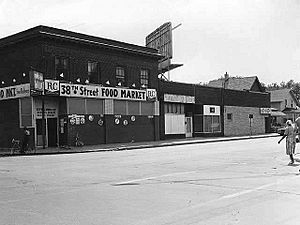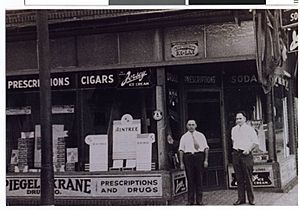38th Street (Minneapolis) facts for kids
38th Street is a main road that goes from east to west in Minneapolis, a big city in the United States. It's also known as an official cultural district in the Powderhorn area. This street became a place where people lived after the streetcar line on Chicago Avenue was extended to East 38th Street in 1880.
Since the 1930s, many businesses owned by Black people have been located here. The neighborhoods around 38th Street have a special history because of how Black residents settled there.
After some years of slow economic growth, the look and feel of the 38th Street neighborhood changed in the 2000s. More Latino families moved in, while the number of Black and White residents went down. In the 2010s, people worried about "gentrification," which is when new, often more expensive, businesses and residents move into an area, sometimes changing its original character. Residents and city leaders wanted to keep the historic cultural feel of 38th Street.
On May 25, 2020, a very sad event happened near the Cup Foods store, which is at the intersection of 38th Street and Chicago Avenue. This event, the tragic death of George Floyd, made the 38th and Chicago intersection known all over the world.

A food market at East 38th Street and 4th Avenue South in Minneapolis, 1975
|
|
| Owner | City of Minneapolis |
|---|---|
| Location | Minneapolis, Minnesota, United States |
| Nearest metro station | 38th Street station |
| Coordinates | 44°56′03″N 93°15′45″W / 44.9342°N 93.2625°W |
| Major junctions |
|
| East | East 38th Street |
| West | West 38th Street |
| Other | |
| Known for |
|
| Website | minneapolismn.gov |
Contents
Exploring 38th Street's Location
In Minneapolis, 38th Street runs from east to west. West 38th Street goes from Excelsior Boulevard to Nicollet Avenue. However, it's broken up by Bde Mka Ska lake and Lakewood Cemetery.
East 38th Street is the part of the road from Nicollet Avenue to the West River Parkway near the Mississippi River.
The Famous 38th and Chicago Intersection
East 38th Street crosses Chicago Avenue, which is a major road going north and south. This intersection is in the city's Powderhorn community. The area where 38th and Chicago meet is a border for several city neighborhoods. These include Bancroft, Bryant, Central, and Powderhorn Park.
These four neighborhoods have a unique history in Minneapolis. This is due to how different racial and ethnic groups settled and developed there over the last century. By the 2020s, about 25,000 people lived in these neighborhoods.
A Look Back at 38th Street's History
The area around 38th Street has a rich past, from being added to Minneapolis to becoming a vibrant cultural district.
How 38th Street Joined Minneapolis
In the mid-1800s, the land was mapped out. At that time, 38th Street was part of Richfield in Hennepin County. In 1867, the Minnesota Legislature created Minneapolis Township. This was a separate area south of Lake Street.
In 1883, the Powderhorn area, which includes 38th Street, became part of the City of Minneapolis. This made 38th Street the city's southern border. The rest of the township was added to the city in 1887.
Streetcars and Neighborhood Growth
People started building homes in the 38th Street area in the 1870s. But it was hard for them to get to downtown Minneapolis because there wasn't public transportation. In 1880, trolley lines on Chicago Avenue were extended to 38th Street. This made it much easier for people to travel downtown.
In 1926, a bus line was added on 38th Street, running east and west. It was extended a few years later. The area quickly grew into a busy neighborhood with many shops and homes, all connected by the Chicago Avenue trolley line.
The first people to live in the neighborhoods along 38th Street were from Sweden and Norway. By the 1920s, the area was very diverse. It had people from many backgrounds, including African American, Jewish, and people from Southern and Eastern Europe. Many Black residents moved to south Minneapolis, near 38th Street, during the Great Migration. This was a time in the early 1900s when many Black people moved north from rural southern states.
A Hub for Black Residents and Businesses
From the 1930s to the 1970s, the neighborhoods along East 38th Street were a lively center for Black residents and businesses in south Minneapolis. Many Black residents lived in the area from East 34th to 46th streets south, and from Nicollet to Chicago avenues.
In the 1900s, unfair housing rules, like racial covenants that stopped Black people from buying homes in certain areas, and a practice called redlining, caused Black residents to be concentrated in this area. Also, businesses in mostly White areas often refused to serve Black customers. This led to the growth of Black-owned businesses. The 38th Street area became a popular spot for Black residents and visitors to Minneapolis who wanted to find businesses that would welcome them. East 38th Street and 4th Avenue South had Black-owned cafes, delis, newspaper offices, and shops.
The Spokesman-Recorder Newspaper
The Minnesota Spokesman-Recorder newspaper was started in 1934 by Cecil Newman. It is the oldest Black newspaper in Minnesota that has been running continuously. Since 1958, its office has been located near East 38th Street and Fourth Avenue South. In 2015, the building was recognized as a historic landmark.
Changes and Challenges Over Time
The historic Black business district faced challenges when the Interstate 35W highway was built in Minneapolis in 1959. This construction cleared fifty square blocks and created a large gap that cut across 38th Street, splitting the neighborhood in half.
The neighborhood also changed when its population decreased and Central High School nearby closed in 1982. From the 1980s to the 2000s, the area saw an increase in crime and a decline in local economic conditions. By the 2000s, many Black-owned businesses that had been in the neighborhood for decades had to close.
New Residents and Gentrification Concerns
In the late 1900s and early 2000s, the number of both White and Black residents in the area went down. Then, many Latino families moved in, looking for affordable homes. The Latino population soon became larger than both the White and Black populations.
In the 2010s, after many years of slow economic growth, several new businesses opened on 38th Street. Some of these were owned by White business owners who did not live in the neighborhood. Many new businesses opened in storefronts that had been empty for years. People started to worry about "gentrification." This led to discussions about how to keep the historic Black character of the area.
Becoming a Cultural District
In 2015, residents and Minneapolis city leaders began planning how to protect African American history and culture in the area. In 2019, local officials started the "38th Street Thrive!" plan. This plan aimed to officially create a 38th Street cultural district.
As part of the "Minneapolis 2040" zoning plan, city officials officially named the wider 38th Street South area as one of the city's seven new cultural districts in August 2020. This was done to support fairness for all races, keep cultural identity strong, and help the economy grow. The official 38th Street Cultural District includes parts of 37th to 39th streets south, from Nicollet to Bloomington avenues.
Special Street Names
Some parts of the streets around 38th Street have been given special names to honor important people.
The section of 3rd Avenue South between 36th Street and 42nd Street was named "Clarissa Rogers Walker Way." This honors Clarissa Rogers Walker, who was a social activist and community leader in the mid-to-late 1900s.
The section of 4th Avenue South between 36th Street and 42nd Street was named "Launa Q. Newman Way." This honors Launa Q. Newman, who was the president of the Minnesota Spokesman-Recorder newspaper. Her husband, Cecil Newman, founded the newspaper.
The section of Chicago Avenue between 37th and 39th streets was renamed "George Perry Floyd Jr Place." This was done to honor George Floyd, whose tragic death occurred outside the Cup Foods store on May 25, 2020. In May 2022, it was renamed again to "George Perry Floyd Square."
Images for kids




